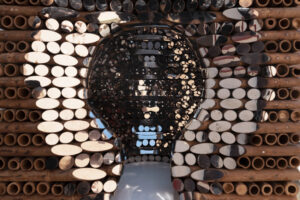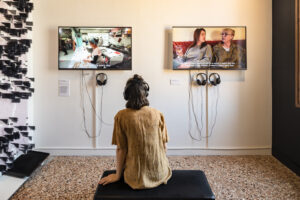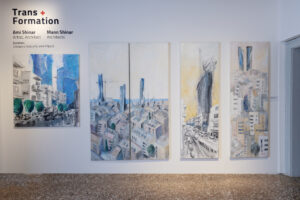European Cultural Centre (ECC) in Venice, a non-profit cultural organization headquartered in the Netherlands, aims to promote culture through international exchanges by hosting annual exhibitions of contemporary art, design and architecture around the world, as well as conferences, workshops and other events. This year, as part of the 6th edition of the biennial architecture exhibition, titled “Time Space Existence,” the Venetian venues of Palazzo Bembo, Palazzo Mora and Giardini della Marinaressa opened to the public with projects aimed at reflecting on sustainability in its many forms, focusing on the environment and urban landscape, without turning away from other significant issues such as innovation, reuse and community.

Pedro Friedeberg, Hipnerotópolis, The city of love dreams at Time Space Existence 2023, Palazzo Bembo. Photo credits Federico Vespignani, courtesy European Cultural Centre (ECC) Venice
Just a stone’s throw from Rialto, with a glimpse on the Grand Canal from the ancient windows of Palazzo Bembo, we encounter the project by Mexican artist Pedro Friedeberg (1936), Italian by birth, who captivates visitors with astonishing sculptural works and paintings: bizarre visual compositions made with multiple references, from archaeology to Latin American references, from “cheeky” body parts to everyday objects, animals, colors and shapes of all kinds. Nothing escapes the infinite imagination of the artist, who knows how to start from significant visual cues to create a surprisingly surreal result. Friedeberg is best known to the public for the 1960s sculptural chair Hand, made in the shape of a hand, a version of which is currently on display at the main floor hall of the Venetian palace. Like Friedeberg, U.S. artist Curtis Patterson, who lives and works in Atlanta, Georgia, is a proponent of unprecedented modular design that originates from the juxtaposition of similar and dissimilar elements and from which an ancestral visual message shines through: Patterson’s works, from small to large-scale, carrying a primordial symbolism, the elements of which serve as indelible references to the historical contributions of people of African descent. So does Hymn to Freedom, a sculpture on display at Palazzo Mora, a tribute to the musical genius of jazz virtuoso pianist Oscar Peterson and his 1962 musical piece of the same name. The sculpture also evokes the courageous act of two Olympians, Tommie Smith and John Carlos, who won the gold and bronze medals, respectively, at the 1968 Olympic Games in Mexico City and held their fists up and heads bowed during the award ceremony as a sign of opposition and the need to fight civil injustice in the world.

Deng Xiao, Mobile Bamboo Pavilion Series N01 + 02 at Time Space Existence 2023, Palazzo Mora. Photo credits Federico Vespignani, courtesy European Cultural Centre (ECC) Venice
Catalyzing spiritual energies through form is a concept also explored by Chinese artist Deng Xiao. His Mobile Bamboo Pavilion series, exhibited at Palazzo Mora, is an art installation, made of stainless steel, that creates an immersive space, where the viewer is surrounded by shapes, alternate light, shadows and reflections: entering the large concave space, in fact, bamboo is cut from a spherical shape, forming a natural surface inlaid with stainless steel mirrors. Deng’s eyes look to the essence of the unknown, evoking a sense of wonder and fascination with their ability to manifest the enigmatic and intangible. If in their investigation of the extraordinary Friedeberg, Patterson and Xiao are veritable wizards of form, another artist exhibited at the Palazzo Bembo venue instead engages in a painstaking search for the ordinary, to emphasize its importance in the same way as the heroic and the monumental. Patricia MacKinnon-Day has spent the past twenty-five years observing places such as shipyards, housing estates, historic sailing ships and farms, with the goal of investigating overlooked moments of lived experience and making visible some of their details. The Start of All Imaginings (2023) is the project presented for this edition of “Time Space Existence”: two televisions respectively show the personal journey of nine merchants from an old traditional market to a new space, and a film where the merchants themselves are filmed watching the documentary from home and in the act of commenting on the experience. In the first film, Market Trader Stories, a series of short videos express the excitement and anticipation on the part of nine traders as they move into a new market space after waiting decades for its development. The arrival is represented by a slow-motion clip of Panis Angelicas sung by Grace Crook, a Chester Cathedral chorister, evoking the feeling that the merchants have completed a challenging journey and are now elated for the arrival of the big day. The second film, At Home with the Market Traders, is a commentary on the narratives by market users, filmed watching from home. The exchanges initiate conversations about the importance of markets, how they contribute to a sense of place, and what this means in the context of regeneration.

Patricia MacKinnon-Day, The Start of All Imaginings at Time Space Existence 2023, Palazzo Bembo. Photo credits Matteo Losurdo, courtesy European Cultural Centre (ECC) Venice
Young artist Elyssa Sykes-Smith (1991) also turns her gaze toward communities in creating art for public space and devising participatory projects. Australian by origin, Elyssa Sykes-Smith looks at the climate crisis and the unpleasant experiences related to it that lead to living the issue with anxiety and apprehension. In Sykes-Smith’s case, the creation of Canopy of Thoughts – an installation that branches between the spaces of Palazzo Mora, emulating flames spreading high – is linked to her mother figure: in 2019/2020 due to climate-related wildfires in Australia, Mrs. Sykes had to evacuate while her daughter was in Germany, hundreds of miles away. Elyssa Sykes-Smith does not forget this experience and stresses the importance of incorporating arts practice into the sciences to support human rights and environmental sustainability.

Elyssa Sykes-Smith, Canopy of Thoughts at Time Space Existence 2023, Palazzo Mora. Photo credits Federico Vespignani, courtesy European Cultural Centre (ECC) Venice
Sharing a concern for the rapid changes taking place in the urban fabric and the human experience associated with them is Israeli artist-architect Ami Shinar, who presents at Palazzo Mora Trans+Formation, a room curated by Ermanno Tedeschi and Vera Pilpou, dedicated to urban and social transformation as it relates to his hometown of Tel Aviv. Known as an architect for the duo “Mann-Shimar Architects,” a firm founded in 1991 that has won numerous awards and urban design projects – including the new “Ramon Airport” and recently the new National Library of Israel in collaboration with Herzog & de Meuron in Jerusalem – Ami Shinar is also an artist who intensely observes every detail of his city and its spirit. Watercolors and paintings stage real moments, contrasts and gaps, transformations, significant places and especially people, all mastered on shades of white, blue and green, colors through which Shinar translates every situation around him. “My Urban Works depict the immense urban (as well as social) transformation occurring in my city. Practically it occurs all over most of the globe as the urban population is growing. Tel Aviv is just one example where numerous new skyscrapers overshadow the old human-scale built fabric. This is a controversial issue which I am also aware of as an architect. But we cannot forget that the urban essence is its people. Walking in the marginal neighbourhoods of my city while drawing old houses that carry memories, as well as people’s faces, some of them are “transparent” work immigrants, this is art with a subtle social statement”. Also among the works on display there is a “political” series dedicated to the iconic mass protests of the “Handmaid Tale” marches, the women in red, who follow Canadian writer Margaret Atwood’s book and TV drama, and who fight for the defense of democracy in Israel.

Ami Shinar, Trans + Formation at Time Space Existence 2023, Palazzo Mora. Photo credits Federico Vespignani, courtesy European Cultural Centre (ECC) Venice
In the meaningful combination of works and projects from all over the world, “Time Space Existence”, organized and promoted by European Cultural Centre in Venice, appears not only as an exhibition but also as an active laboratory, where established professionals and emerging architects can work together for a better future, presenting their visions on the state of architecture and the environment around it.
Info:
VV. Time Space Existence
Venezia: Palazzo Bembo, Palazzo Mora, Giardini della Marinaressa
Promotore: European Cultural Centre
Organizzatori: Benedetta Bianchi, Elisa Dallanoce, Sara Danieli, Rachele De Stefano, Hadi El Hage, Bérénice Freytag, Ilaria Marcatelli, Vittoria Mastrolilli, Lucia Pedrana, Martina Rodella, Lucia Trevisan, Suzanne van der Borg, Elena Volpato
20/05 – 26/11/2023
https://timespaceexistence.com/ – https://ecc-italy.eu/
Independent curator specialized in Argentine art, with studies and publications on the subject (“Argentina at the Venice Biennale of Art” in Storie della Biennale di Venezia, Ed. Ca’ Foscari, 2020), founder in 2014 of arteargentina.it, the first Italian platform dedicated to Argentine art in Italy. She currently collaborates in Venice with galleries and artists.






NO COMMENT